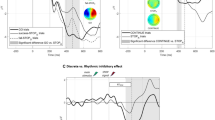Abstract
We studied the effect of the complexity of the secondary task on event-related EEG dynamics over the sensorimotor cortex in primary task under multitasking conditions. 32-channel EEG was recorded from 24 healthy subjects during the performance of four tests combining Go/NoGo and N-back paradigms and differing in complexity. In contrast to the previous studies using the classical paradigm of N-back tasks requiring memorization of information about the stimuli itself, for this study we developed a variant of the N-back task, which requires memorization of the completed action. It was shown that an increase in the complexity of the N-back task leads to a decrease in the magnitude of beta synchronization observed after a movement in the Go condition of the Go/NoGo task over the left sensorimotor cortex (electrode C3). It can be assumed that an increase in working memory load, regardless of the type of information held in memory, leads to a deterioration in the processes of movement control necessary to perform the primary task. The obtained results support the assumption that the multitasking condition requires the distribution of attention resources and, due to this, decreases the quality of each task performance.


Similar content being viewed by others
REFERENCES
Scherbaum S, Gottschalk C, Dshemuchadse M, Fischer R (2015) Action dynamics in multitasking: the impact of additional task factors on the execution of the prioritized motor movement. Front Psychol 6: 934. https://doi.org/10.3389/fpsyg.2015.00934
Romeo Z, Bonato M, Zorzi M, Spironelli C (2019) Electrophysiological correlates of spatial processing during multitasking. Neuropsychologia 133: 107152. https://doi.org/10.1016/j.neuropsychologia.2019.107152
Madore KP, Khazenzon AM, Backes CW, Jiang J, Uncapher MR, Norcia AM, Wagner AD (2020) Memory failure predicted by attention lapsing and media multitasking. Nature 587(7832): 87–91. https://doi.org/10.1038/s41586-020-2870-z
Hennah C, Ellis G, Doumas M (2021) Dual task walking in healthy aging: Effects of narrow and wide walking paths. PLoS One 16(12): e0261647. https://doi.org/10.1371/journal.pone.0261647
Pizzamiglio S, Naeem U, Abdalla H, Turner DL (2017) Neural Correlates of Single- and Dual-Task Walking in the Real World. Front Hum Neurosci 11: 460. https://doi.org/10.3389/fnhum.2017.00460
Lavie N, Hirst A, de Fockert JW, Viding E (2004) Load theory of selective attention and cognitive control. J Exp Psychol Gen 133: 339–354. https://doi.org/10.1037/0096-3445.133.3.339
Capizzi M, Correa A, Sanabria D (2013) Temporal orienting of attention is interfered by concurrent working memory updating. Neuropsychologia 51(2): 326–339. https://doi.org/10.1016/j.neuropsychologia.2012.10.005
Bayramova R, Toffalini E, Bonato M, Grassi M (2021) Auditory selective attention under working memory load. Psychol Res 85(7): 2667–2681. https://doi.org/10.1007/s00426-020-01437-7
Zanto TP, Liu H, Pan P, Gazzaley A (2020) Temporal attention is not affected by working memory load. Cortex 130: 351–361. https://doi.org/10.1016/j.cortex.2020.06.008
Scharinger C, Soutschek A, Schubert T, Gerjets P (2017) Comparison of the Working Memory Load in N-Back and Working Memory Span Tasks by Means of EEG Frequency Band Power and P300 Amplitude. Front Human Neurosci 11: 6. https://doi.org/10.3389/fnhum.2017.00006
Pfurtscheller G, Lopes da Silva FH (1999) Event-related EEG/MEG synchronization and desynchronization: basic principles. Clin Neurophysiol 110: 1842–1857. https://doi.org/10.1016/s1388-2457(99)00141-8
Pesonen M, Hämäläinen H, Krause CM (2007) Brain oscillatory 4-30 Hz responses during a visual n-back memory task with varying memory load. Brain Res 1138: 171–177. https://doi.org/10.1016/j.brainres.2006.12.076
Kropotov JD, Ponomarev VA, Pronina MV, Jäncke L (2017) Functional indexes of reactive cognitive control: ERPs in cued go/no-go tasks. Psychophysiology 54(12): 1899–1915. https://doi.org/10.1111/psyp.12960
Ponomarev VA, Pronina MV, Kropotov YD (2017) Dynamics of the EEG spectral density in the θ, α, and β bands in the visual Go/NoGo task. Hum Physiol 43: 366–376. https://doi.org/10.1134/S0362119717040132
Kayser J, Tenke CE (2015) On the benefits of using surface Laplacian (Current Source Density) methodology in electrophysiology. Int J Psychophysiol 97(3): 171–173. https://doi.org/10.1016/j.ijpsycho.2015.06.001
Başar E, Düzgün A (2016) How is the brain working?: research on brain oscillations and connectivities in a new “take-off” state. Int J Psychophysiol 103: 3–11. https://doi.org/10.1016/j.ijpsycho.2015.02.007
Maris E, Oostenveld R (2007) Nonparametric statistical testing of EEG- and MEG-data. J Neurosci Methods 164(1): 177–190. https://doi.org/10.1016/j.jneumeth.2007.03.024
Wessel JR, Aron AR (2017) On the globality of motor suppression: unexpected events and their influence on behavior and cognition. Neuron 93(2): 259–280. https://doi.org/10.1016/j.neuron.2016.12.013
Barone J, Rossiter HE (2021) Understanding the Role of Sensorimotor Beta Oscillations. Front Systems Neurosci 15: 655886. https://doi.org/10.3389/fnsys.2021.655886
Heinrichs-Graham E, Kurz MJ, Gehringer JE, Wilson TW (2017) The functional role of post-movement beta oscillations in motor termination. Brain Struct Funct 222(7): 3075–3086. https://doi.org/10.1007/s00429-017-1387-1
Solis-Escalante T, Müller-Putz GR, Pfurtscheller G, Neuper C (2012) Cue-induced beta rebound during withholding of overt and covert foot movement. Clin Neurophysiol 123(6): 1182–1190. https://doi.org/10.1016/j.clinph.2012.01.013
Cao L, Hu Y-M (2016) Beta Rebound in Visuomotor Adaptation: Still the Status Quo? J Neurosci 36(24): 6365–6367. https://doi.org/10.1523/JNEUROSCI.1007-16.2016
Tan H, Wade C, Brown P (2016) Post-Movement Beta Activity in Sensorimotor Cortex Indexes Confidence in the Estimations from Internal Models. J Neurosci 36(5): 1516–1528. https://doi.org/10.1523/JNEUROSCI.3204-15.2016
Little S, Bonaiuto J, Barnes G, Bestmann S (2019) Human motor cortical beta bursts relate to movement planning and response errors. PLoS Biol 17(10): e3000479. https://doi.org/10.1371/journal.pbio.3000479
ACKNOWLEDGMENTS
The team of authors is grateful to Maxim Vladimirovich Kireev, a senior researcher at the Institute of the Human Brain of the Russian Academy of Sciences, Doctor of Biological Sciences, for his participation in the development of the test design.
Funding
The work was performed within the state assignment of the Ministry of Science and Higher Education of the Russian Federation, theme no. FMMW-2022-0002.
Author information
Authors and Affiliations
Contributions
Idea of the study, planning of the experiment, test assignment development (M.V.P., V.A.P., Yu.D.K.), data collection (M.V.P.), data processing (M.V.P., V.A.P.), writing and editing of the manuscript (M.V.P., V.A.P., Yu.D.K.).
Corresponding author
Ethics declarations
CONFLICT OF INTEREST
The authors declare that they have no conflicts of interest.
Additional information
Translated by A. Dyomina
Russian Text © The Author(s), 2022, published in Rossiiskii Fiziologicheskii Zhurnal imeni I.M. Sechenova, 2022, Vol. 108, No. 11, pp. 1442–1452https://doi.org/10.31857/S0869813922110103.
Rights and permissions
About this article
Cite this article
Pronina, M.V., Ponomarev, V.A. & Kropotov, Y.D. Effect of Task Complexity on the Post-Movement Beta Synchronization in the Sensorimotor Cortex. J Evol Biochem Phys 58, 1905–1913 (2022). https://doi.org/10.1134/S0022093022060199
Received:
Revised:
Accepted:
Published:
Issue Date:
DOI: https://doi.org/10.1134/S0022093022060199




